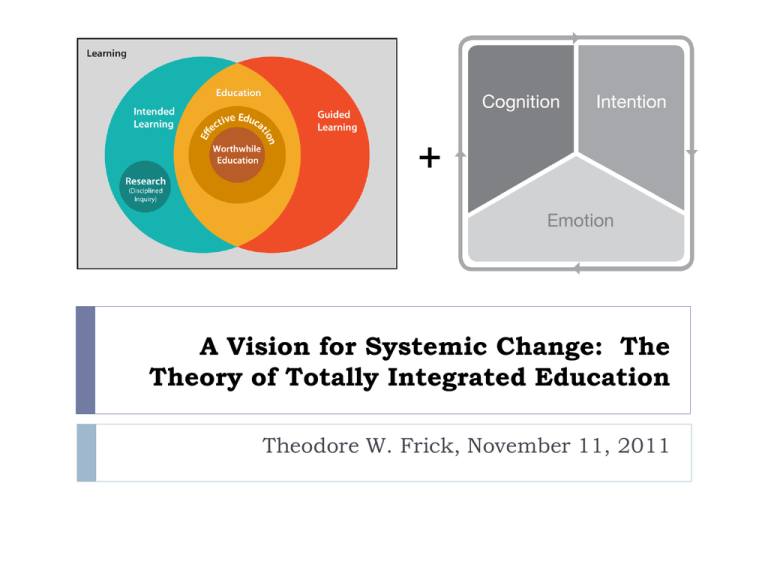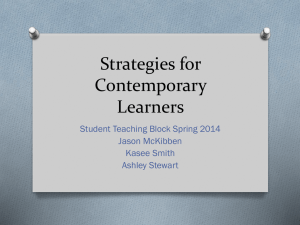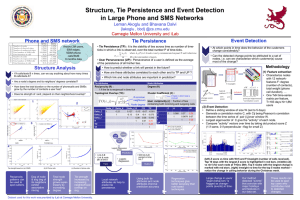The Theory of Totally Integrated Education (TIE)
advertisement

+ A Vision for Systemic Change: The Theory of Totally Integrated Education Theodore W. Frick, November 11, 2011 TIE: Totally Integrated Education Connecting cognition, intention and emotion with 9 kinds of worthwhile learning outcomes—27 connections 2 TIE Theory 11/11/11 TIE Theory provides a vision for systemic change in education. Not how to do it, but what to aim for. 3 TIE Theory 11/11/11 TIE theory provides a vision for creating worthwhile education. TIE theory further provides a rationale for these aims. Fundamental to TIE is the notion of aligning student cognition, intention and emotion with authentic learning tasks. When this is done well, student learning is predicted to be more flexible and whole, and less vulnerable to forgetting. 4 TIE Theory 11/11/11 Typical Learning Outcomes In Current Education System Learning Outcomes Envisioned by TIE Theory 5 TIE Theory 11/11/11 We should seek worthwhile education which is totally integrated 6 TIE Theory 11/11/11 Overview Importance of alignment of cognition, intention and emotion Completely connected kinds of knowing Distinctions among learning, education, effective education, and worthwhile education Need for task-centered vs. topic-centered curriculum development Retroduction for TIE theory development 7 TIE Theory 11/11/11 Connecting Cognition, Intention and Emotion 8 TIE Theory 11/11/11 Importance of connecting cognition, intention and emotion Dewey (1916): meaningful experience and thinking 9 “Thinking, in other words, is the intentional endeavor to discover specific connections between something we do and the consequences which result…” (p. 145, italics added) “Experience as trying involves change, but change is meaningless transition unless it is consciously connected with the return wave of consequences which flow from it. When an activity is continued into the undergoing of consequences, when the change made by action is reflected back into the change made in us, the mere flux is loaded with significance. We learn something.” (p. 139, italics added) TIE Theory 11/11/11 Importance of connecting cognition, intention and emotion (cont’d) Greenspan & Benderly (1997): emotion is the architect of mental structures “In fact, emotions, not cognitive stimulation, serve as the mind’s primary architect” (p. 1). They identify the importance of emotion during human experience: “… each sensation … also gives rise to an affect or emotion…. It is this dual coding of experience that is the key to understanding how emotions organize intellectual capacities …” (p. 18). 10 TIE Theory 11/11/11 Importance of connecting cognition, intention and emotion (cont’d) Goleman (2011): emotional intelligence “When we have a thought it’s immediately valenced by these brain centers, positive or negative.” Goleman is referring to “… emotional centers in the midbrain, interacting with a specific area in the prefrontal cortex” [Kindle location 116]. 11 TIE Theory 11/11/11 Yet, what is happening in schools today Results from a survey of 81,499 students in 110 high schools across 26 U.S. states (Yazzie-Mintz, 2007): Approximately 2 out of 3 students said that they were bored in class every day. Top reasons were that learning materials were uninteresting, irrelevant and not challenging enough. E.g., students said: 12 “Our school needs to be more challenging. Students fall asleep because the classes aren’t really that interesting.” “School is easy. But too boring. Harder work or more is not the answer though. More interesting work would be nice” (p. 10). TIE Theory 11/11/11 Lack of integration of cognition with emotion and intention Too often students are expected to engage with content they really do not want to learn nor do they feel good about it. Cognition is disconnected with intention and emotion. 13 TIE Theory 11/11/11 Lack of integration of cognition with emotion and intention: TIE theory predicts: To focus only on student cognitive development at the expense of intention and emotion will result in weaker or disconnected mental schema. Such schema will lack wholeness and hence would be poorly integrated into existing mental structures, much like an uninvited guest at a party who stands in the corner of the room and does not interact with other invited guests. If students do make cognitive gains, but they are indifferent or have negative feelings about the learning experience, then such schema would be more vulnerable to forgetting due to lack of integration. 14 TIE Theory 11/11/11 On the other hand, complete connectedness occurs during learning tasks when: Cognition: S comes to know X. Intention: S intends to learn X. Emotion: S feels good about learning X. Where S represents the student, and X represents the 9 kinds of connected learning outcomes: instantial, relational, criterial, imitative, adaptive, creative, recognitive, acquaintive, and appreciative. 15 TIE Theory 11/11/11 Connecting cognition, intention and emotion is represented by this diagram: 16 TIE Theory 11/11/11 There are three basic kinds of cognitive learning outcomes (Maccia, 1987; Frick, 1997): 17 TIE Theory 11/11/11 Completely-connected learning outcomes where cognition, intention and emotion are aligned with knowing that, knowing how and knowing that one 18 TIE Theory 11/11/11 Nine specific types of learning outcomes: 19 TIE Theory 11/11/11 TIE theory predicts that when cognition, intention and emotion are completely connected with 9 types of learning outcomes (27 connections total), then vulnerability to forgetting is minimized. 20 TIE Theory 11/11/11 Partially connected learning outcomes: Note the empty areas which indicate missing connections 21 TIE Theory 11/11/11 Typical learning outcomes in school: Note that know that one is missing and not connected to know that or how; know how and that are disconnected; intention and emotion are missing everywhere. 22 TIE Theory 11/11/11 TIE Theorem What is learned (X) will be less vulnerable to forgetting (because mental structures are stronger and more flexible) when Cognition, intention and emotion are aligned (S comes to know X; S intends to learn X; S feels good about learning X) AND Nine kinds of learning tasks are integrated (knowing that, knowing how, and knowing that-one) AND Learning tasks mastered by students are authentic and whole. 23 TIE Theory 11/11/11 For each educational objective or standard, fully integrated learning outcomes are depicted below. 24 TIE Theory 11/11/11 Definitions in TIE Theory Learning, education, effective education, worthwhile education 25 TIE Theory 11/11/11 Learning: increasing complexity of mental structure Mental structure: affect-relations (schema) which constitute a person’s intelligence Complexity: number of connections among components of a system (Thompson, 2008a; 2008b) Increasing complexity: more connections than before Consistent with empirical findings in neuroscience by Nobel Prize winner Eric Kandel (1989): long-term memory is “associated with growth in synaptic connections [among neurons]” (p. 115), and that “learning produces enduring changes in structure and function of synapses” (p. 121). Greenspan & Shanker (2004): emotion and intention determine these structures through dual coding of experience 26 TIE Theory 11/11/11 Learning: all kinds 27 TIE Theory 11/11/11 Intended Learning (by a student) 28 TIE Theory 11/11/11 Guided Learning (by a teacher) 29 TIE Theory 11/11/11 Education: intended & guided learning (Steiner, 1988) 30 TIE Theory 11/11/11 Effective Education: instrumentally good (it works—achieves desired ends or goals) 31 TIE Theory 11/11/11 Worthwhile Education: instrumentally and intrinsically good 32 TIE Theory 11/11/11 Big Picture: learning and education 33 TIE Theory 11/11/11 Effective education that is not worthwhile 34 TIE Theory 11/11/11 Ineffective Education 35 TIE Theory 11/11/11 Compelled Learning: guided & not intended (what often occurs in many U.S. schools) 36 TIE Theory 11/11/11 Research: Intended learning that is disciplined but unguided (by a teacher) 37 TIE Theory 11/11/11 Discovery Learning: Intended learning that is undisciplined and unguided 38 TIE Theory 11/11/11 Accidental Learning: unintended and unguided 39 TIE Theory 11/11/11 Big Picture: learning and education 40 TIE Theory 11/11/11 Education: intended, guided learning Steiner (1988): Education occurs when someone (teacher) intentionally guides the learning of another (student) who intends to learn something (content—X) somewhere (context) In other words, development of intelligence occurs through education—intended, guided learning. Education is taken broadly: teachers are not limited to those in K-12 and college instruction; students are not limited to young people; content not limited to traditional subjects; contexts not limited to schools and universities. 41 TIE Theory 11/11/11 Worthwhile education is needed Effective education occurs if attempts at intended, guided learning result in intended outcomes. Not all education is effective. Worthwhile education occurs if it is instrumentally valuable and intrinsically valuable. 42 Not all effective education is worthwhile. Worthwhile education must be intrinsically good. TIE Theory 11/11/11 Totally integrated education Must be worthwhile education (i.e., it is both instrumentally and intrinsically good); and Results in completely connected learning outcomes: cognition, intention and emotion are aligned with 9 kinds of knowing. 43 Knowing that: instantial, relational & criterial Knowing how: imitative, adaptive & creative Knowing that one: recognitive, acquaintive & appreciative TIE Theory 11/11/11 TIE theory predicts that when cognition, intention and emotion are completely connected with 9 types of learning outcomes, then vulnerability to forgetting is minimized. 44 TIE Theory 11/11/11 How can we do this? Develop a task-centered curriculum rather than a topic-centered curriculum 45 TIE Theory 11/11/11 Examples of approaches to whole task learning Problem-based and project-based learning Pebble-in-the-pond approach via First Principles of Instruction (Merrill, Barclay & van Schaak, 2008) 4C/ID Model (van Merriënboer & Kirschner, 2007) Montessori Method (cf. Lillard, 2008) New Tech High Schools 46 TIE Theory 11/11/11 4C/ID Model (van Merriënboer & Kirschner, 2007) 47 TIE Theory 11/11/11 Pebble-in-the-Pond ID (Merrill, et al., 2008) 48 TIE Theory 11/11/11 Implication We need to change our curriculum from a topic-centered to a task-centered organization of learning experiences. “Revising the curriculum and standards” is one of six common systemic change interventions observed in How the world’s most improved school systems keep getting better (Mourshed, Chijioke & Barber, 2010, p. 20) 49 TIE Theory 11/11/11 Summary When student cognition, intention and emotion are integrated with 9 types of knowing, TIE theory predicts that vulnerability to forgetting will be decreased—i.e., mental structures developed within students are more likely to remain whole because they are stronger and more flexible. This has been but a brief overview of TIE theory. A monograph is online which explains TIE theory in greater depth at: http://educology.indiana.edu/Frick/TIEtheory.pdf 50 TIE Theory 11/11/11 Development of TIE theory TIE theory has been retroduced from: Theory of signs (C. S. Peirce, 1932; T. L. Short, 2007) Epistemology of cognitive educational objectives (G. S. Maccia, 1987) Theory of education, methodology of theory construction (E. Steiner, 1988) General system theory (L. von Bertalanffy, 1950; Maccia & Maccia, 1966; Thompson, 2006) Retroduction 51 New theory is devised by using other extant theory as models from which ideas are taken (C. S. Peirce, 1877; Steiner, 1988) Retroduction contrasts with deduction (for explicating theory) and induction (for verifying theory) TIE Theory 11/11/11 Acknowledgment Thanks to Colin Gray for creating the graphics in this presentation, and to Elizabeth Boling for drawings that illustrate basic kinds of knowing. 52 TIE Theory 11/11/11 References Bateson, G. (1979). Mind and nature. New York, NY: E. P. Dutton. Brown, D. G. (1970). Knowing how and knowing that, what. In G. Pitcher and O. Wood (Eds.), Ryle: A Collection of critical essays (pp. 213-248). Garden City, NY: Doubleday. Cornford, F. M. (translator, 1945). The Republic of Plato. New York, NY: Oxford University Press. Dewey, J. (1916). Democracy and education. New York, NY: The Free Press. Estep, M. (2006). Self-organizing natural intelligence: Issues of knowing, meaning and complexity. Dordrecht, The Netherlands: Springer. Frick, T. W. (1997). Artificially intelligent tutoring systems: What computers can and can’t know. Journal of Educational Computing Research, 16(2), 107-124. Geach, P. (1964). Mental acts. New York, NY: The Humanistic Press. Gore, A. (2006). An inconvenient truth. New York, NY: Rodale Books. Greenspan, S. I. & Benderly, B. L. (1997). The growth of the mind and the endangered origins of intelligence. Reading, MA: AddisonWesley. Greenspan, S. I. & Shanker, S. G. (2004). The first idea: How symbols, language, and intelligence evolved from our primate ancestors to modern humans. Cambridge, MA: Da Capo Press (Kindle edition). Goleman, D. (2011). The brain and emotional intelligence: New insights (Kindle Ed.). Northhampton, MA: More Than Sound LLC. Henneberg, M. (1998). Evolution of the human brain: Is bigger better? Clinical and Experimental Pharmacology and Physiology, 25(9), 745-749. Kandel, E. R. (1989). Genes, nerve cells, and the remembrance of things past. Journal of Neuropsychiatry, 1(2), 103-125. Kandel, E. R. (2001). The molecular biology of memory storage: A dialogue between genes and synapses. Science, 294, 10301038. Kant, E. (1785). Grounding for the metaphysics of morals: On a supposed right to lie because of philanthropic concerns (Translated by J. W. Ellington, 1993). Indianapolis, IN: Hackett Publishing. 53 TIE Theory 11/11/11 References (cont’d) Lillard, A. S. (2008). Montessori: The science behind the genius. New York: Oxford University Press. Maccia, G. S. (1986). Right opinion and Peirce’s theory of signs. Paper presented at the Semiotic Studies Faculty Seminar. Retrieved July 17, 2011, from: http://educology.indiana.edu/Maccia/RightOpinionAndPeircesTheoryOfSigns_GSMaccia1987.pdf. Maccia, G. S. (1987). Genetic epistemology of intelligent natural systems. Systems Research, 4(3), 213-218. Retrieved July 17, 2011, from: http://educology.indiana.edu/Maccia/Correspondence_GeneticEpistemologyOfIntelligentNaturalSystems1987.pdf. Maccia, G. S. (1988). Genetic epistemology of intelligent natural systems: Propositional, procedural and performative intelligence. Paper presented at Hangzhou University, China. Retrieved July 17, 2011, from: http://educology.indiana.edu/Maccia/GeneticEpistemologyOfIntelligentSystems_propositionalProceduralPerformativeIntelligenc e1988.pdf. Merrill, M. D., Barclay, M., & van Schaak, A. (2008). Prescriptive principles for instructional design. In J. M. Spector, M. D. Merrill, J. van Merriënboer, & M. F. Driscoll (Eds.), Handbook of research on educational communications and technology (3rd ed., pp. 173– 184). New York: Lawrence Erlbaum Associates. Mendenhall, A., Buhanan, C. W., Suhaka, M., Mills, G., Gibson, G. V., & Merrill, M. D. (2006). A task-centered approach to entrepreneurship. Tech Trends, 50(4), 84-89. Molenda, M., & Rice, J.M. (1979). Simulation review: The Diffusion Simulation Game. Produced and distributed by the University Consortium for Instructional Development and Technology (UCIDT). Simulation and Games, 10(4), 459-467. Mourshed, M., Chijioke, C. & Barber, M. (2010). How the world’s most improved school systems keep getting better. London: McKinsey & Co. Retrieved July 22, 2010, from: http://ssomckinsey.darbyfilms.com/reports/schools/How-the-Worlds-MostImproved-School-Systems-Keep-Getting-Better_Download-version_Final.pdf. New Tech Network (n.d.). Retrieved July 17, 2011, from: http://www.newtechnetwork.org/. Peirce, C. S. (1877). The fixation of belief. In J. Buchler (Ed.), The philosophic writings of Peirce. New York: Dover Publications, 1955, 5-22. Peirce, C. S. (1931). Collected papers, Vol. I, Principles of philosophy (C. Hartshorne & P. Weiss, Eds.). Cambridge, MA: Harvard University Press. Peirce, C. S. (1932). Collected papers, Vol. II, Elements of logic (C. Hartshorne & P. Weiss, Eds.). Cambridge, MA: Harvard University Press. 54 TIE Theory 11/11/11 References (cont’d) Peirce, C. S. (1934). Collected papers, Vol.V, Pragmatism and pragmaticism (C. Hartshorne & P. Weiss, Eds.). Cambridge, MA: Harvard University Press. Ryle, G. (1959). The concept of mind. New York, NY: Barnes and Noble. Scheffler, I. (1965). Conditions of knowledge. Glenview, IL: Scott-Foresman. Semmelweis, I. P. (2008). In Encyclopædia Britannica. Retrieved March 12, 2008, from Encyclopædia Britannica Online: http://search.eb.com/eb/article-9066723. Short, T. L. (2007). Peirce’s theory of signs. New York, NY: Cambridge University Press. Squire, L. R. & Kandel, E. R. (1999). Memory: From mind to molecules. New York, NY: Henry Holt and Co. Steiner, E. (1988). Methodology of theory building. Sydney: Educology Research Associates. Steiner, E. (2009). Ethical theory (Lecture notes). Retrieved July 14, 2011, from https://www.indiana.edu/~tedfrick/steiner/Ethical%20Theory.pdf . Thompson, K. R. (2006a). “General system” defined for predictive technologies of A-GSBT (Axiomatic General Systems Behavioral Theory). Scientific Inquiry Journal, 7(1), 1-11. Thompson, K. R. (2006b). Axiomatic theories of intentional systems: Methodology of theory construction. Scientific Inquiry Journal, 7(1), 13-24. Thompson, K. R. (2008a). ATIS glossary. Retrieved July 14, 2011, from http://www.indiana.edu/~aptac/glossary/. Thompson, K. R. (2008b). ATIS graph theory. Columbus, OH: Systems Predictive Technologies. Retrieved from: https://www.indiana.edu/~aptfrick/overview/reports/11ATISgraphtheory.pdf. van Merriënboer, J. J., Kirschner, P.A., & Kester, L. (2003). Taking the load off a learner’s mind: Instructional design for complex learning. Educational Psychologist, 38(1), 5-13. van Merriënboer, J. J. & Kirschner, P.A. (2007). Ten steps to complex learning: A systematic approach to four-component instructional design. Mahwah, NJ: Lawrence Erlbaum Associates. Vreeman, R. & Greene, G. (2007). Medical myths even doctors believe. British Medical Journal, 335(7633), 1288-1289. Yazzie-Mintz, , E. (2007).Voices of students on engagement: A report on the 2006 high school survey of student engagement. Retrieved July 14, 2011, from http://www.eric.ed.gov/PDFS/ED495758.pdf. 55 TIE Theory 11/11/11






